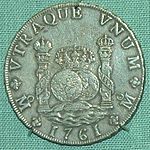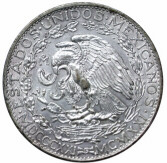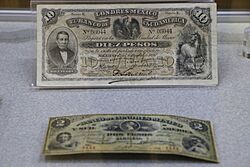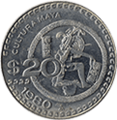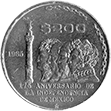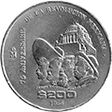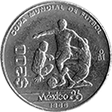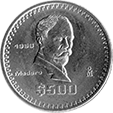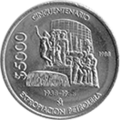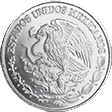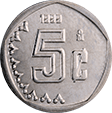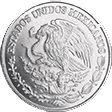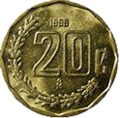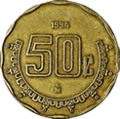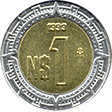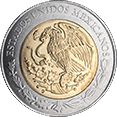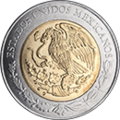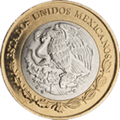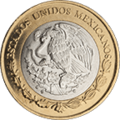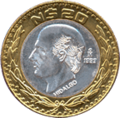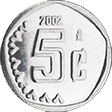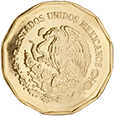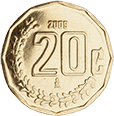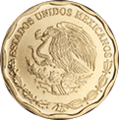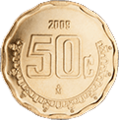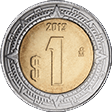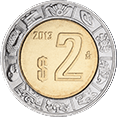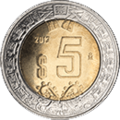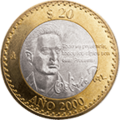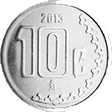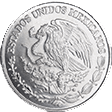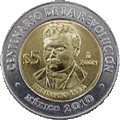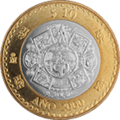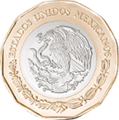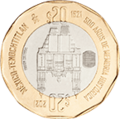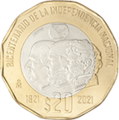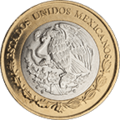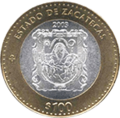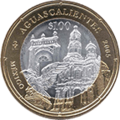Mexican peso facts for kids
Quick facts for kids Mexican peso |
|
|---|---|
| ISO 4217 Code | MXN |
| User(s) | |
| Inflation | 5.61% (2024) |
| Source | Banco de Mexico |
| Subunit | |
| 1⁄100 | centavo |
| Symbol | $ or Mex$ |
| centavo | ¢ |
| Coins | 1, 2, 5, 10, 20 Rarely Used .10, .20, .50 |
| Banknotes | 20, 50, 100, 200, 500, 1000 |
| Printer | Bank of Mexico |
The Mexican peso (symbol: $; currency code: MXN; also called Mex$) is the official money used in Mexico. It's often just called the peso. This currency was first introduced in 1863, replacing the older Spanish colonial real. Each Mexican peso is divided into 100 centavos, which are shown with the symbol "¢".
The Bank of Mexico prints Mexican banknotes in different values. These notes are known for their bright colors and pictures that show off Mexico's rich culture and history. The modern peso and dollar currencies actually share a common history. They both came from the Spanish dollar used between the 16th and 19th centuries, and many still use its famous "$" sign.
Today, the official code for the peso is MXN. The "N" stands for "new peso" because the currency was changed in 1993. Before that, the code MXP was used. The Mexican peso is one of the most traded currencies in the world, ranking 16th overall. It's also the third most traded currency in the Americas, after the US dollar and Canadian dollar, and the most traded in Latin America. As of August 2, 2024, you could exchange about $20.93 Mexican pesos for one euro, $19.18 for one US dollar, and $13.82 for one Canadian dollar.
Contents
History of the Mexican Peso
What does "Peso" mean?
The word peso comes from the Spanish phrase pesos oro (meaning 'gold weights') or pesos plata ('silver weights'). The Spanish word peso simply means "weight." This is similar to how the British pound sterling got its name, referring to a weight of silver. Other countries that use "peso" for their money include Argentina, Chile, Colombia, Cuba, the Dominican Republic, the Philippines, and Uruguay.
Early Money in Mexico
Before the peso, Mexico used a system of money from Spanish America. This system, from the 1500s to the 1800s, included silver reales and gold escudos.
The silver eight-real coins were very important. They weighed about 24.44 grams of pure silver and were widely called pesos in Spanish America and dollars in Britain and its American colonies. These pesos were made from the large amounts of silver found in mines in what is now Mexico and Bolivia. They were sent all over the world, becoming a global standard for silver money until the early 1900s. These coins also inspired the creation of many other currencies, like the United States dollar, the Chinese yuan, and the Japanese yen. Mexican silver pesos were even legal money in the United States until 1857 and in China until 1935.
How the Peso Changed Over Time
While the United States divided its dollar into 100 cents early on (from 1793), Mexico kept the peso divided into 8 reales until 1863. That year, under Emperor Maximilian I of Mexico, Mexico started making pesos divided into 100 centavos.
After Mexico became a republic again, leaders like Benito Juárez and Porfirio Díaz continued to make centavo coins from different metals and gold coins in pesos. However, between 1873 and 1897, they had to bring back the old eight-real silver coin design because merchants in East Asia preferred it.
Over time, the amount of silver in Mexican coins decreased. By 1979, the last silver 100-peso coins were made. The value of the US dollar also changed against the peso, going from 2 silver pesos in 1905 to 12.50 pesos from 1954 to 1976.
The "New Peso" and Big Changes
For most of the 1900s, the Mexican peso was quite stable compared to money in other Latin American countries, which often faced very high inflation.
Big Changes in the 1970s and 1980s
In 1976, the US dollar's value jumped from 12.50 to 19.40 pesos. After an oil crisis in the late 1970s, Mexico had trouble paying back its international loans in 1982. This led to a lot of money leaving the country, causing several years of high inflation and the peso losing much of its value. The US dollar jumped again from 23 to 150 pesos in 1982. This made it very hard for companies with loans in US dollars but earnings in pesos. It led to high unemployment and tough times for many families.
The government tried to fix the economy, but it wasn't until the early 1990s that things started to stabilize. This happened under President Carlos Salinas with a plan called the "Stability and Economic Growth Pact."
Introducing the New Peso in 1993
On January 1, 1993, the Bank of Mexico introduced a new currency called the nuevo peso ("new peso"), which was written as "N$" followed by the amount. One new peso (N$1.00) was equal to 1,000 of the old pesos. This change was made to simplify prices and make the currency easier to use after years of high inflation.
Economic Ups and Downs
The Mexican economy faced more challenges after the North American Free Trade Agreement (NAFTA) was signed in 1994. Unexpected events, like the assassination of a presidential candidate, made the situation worse. Investors became worried and started taking their money out of Mexico. This led to the peso losing a lot of its value very quickly in December 1994. The Bank of Mexico lost a lot of its money trying to keep the peso stable.
This crisis was very tough for Mexican families. The peso lost 82.9% of its value against the US dollar, and interest rates went up a lot. Many men lost their jobs, leading to more married women and teenagers looking for work to help their families. This also caused a big increase in people moving from Mexico to the United States in 1995, looking for better job opportunities.
Things slowly started to get better between 1996 and 1998, as the Mexican government worked to fix the banking system. By the year 2000, the economy became more stable.
Peso Value Changes Over Time
- After the new peso was introduced in 1993, the official exchange rate was N$3 for one US dollar.
- After the Mexican peso crisis in December 1994, the peso quickly dropped from N$3.4 to N$7.2 in 1995.
- It then stayed between N$8 and N$11 from 1998 to 2008.
- During the 2008 global financial crisis, it briefly dropped to N$15.56 in March 2009, but then settled between N$12 and N$14 from 2009 to 2014.
- The peso then dropped from N$14.78 in 2014 to N$17 in 2015.
- From 2016 to 2019, it traded between N$18 and N$20.
- During the COVID-19 pandemic, the peso reached its lowest point at N$25 per dollar.
- From 2020 to 2024, the peso actually gained over 30% in value, becoming one of the best-performing currencies in the world. In April 2024, it reached a nearly nine-year high of N$16.26 per dollar. This was mainly because more foreign companies invested in Mexico and the Bank of Mexico kept a strict money policy to control inflation.
- Since the general elections in 2024, the peso has dropped to over N$19. This is also due to political and economic uncertainty in the United States and global tensions.
Mexican Coins
Old Coins: Reales and Early Pesos
From the 1500s to the 1800s, coins were made in reales and escudos.
- Gold coins came in 1⁄2, 1, 2, 4, and 8 escudos. One escudo was worth about 2 pesos or 16 reales.
- Silver coins came in 1⁄2, 1, 2, 4, and 8 reales. One peso was equal to 8 reales.
Mexico also made copper coins called tlacos, which were worth 1⁄8 of a real. After Mexico became independent, silver coins often had a "cap and ray" design showing a shining Phrygian cap with the word "Libertad" (liberty). This design was well-known to traders in East Asia.
In the 19th century, the Second Mexican Empire (1863-1867) started making coins in pesos and centavos. These included copper 1-centavo coins, silver 5, 10, and 50 centavos, silver 1-peso, and gold 20-peso coins. Later, the Mexican Republic continued making these coins.
20th Century Coins
In 1905, Mexico changed its money system. The amount of gold in the peso was reduced, and most silver coins became token money. New coins were made, including bronze 1 and 2 centavos, nickel 5 centavos, silver 10, 20, and 50 centavos, and gold 5 and 10 pesos.
A famous 1-peso coin, called the "Caballito" (little horse), was made from 1910 to 1914. It's considered one of Mexico's most beautiful coins. It showed the Mexican coat of arms on one side and a woman riding a horse, holding a torch, on the other.
Over the years, the amount of silver in coins continued to decrease until 1979. Between 1960 and 1971, new coins were introduced, including brass 1 and 5 centavos, and cupro-nickel 10, 25, 50 centavos, 1, 5, and 10 pesos. In 1977, silver 100 pesos were made for general use. Later, larger value coins like 20, 50, 100, 200, 500, 1,000, and 5,000 peso coins were introduced, made from different metals.
New Peso Coins (MXN)
As mentioned earlier, the nuevo peso ("new peso") was created in 1993 because of high inflation in the 1980s. President Carlos Salinas de Gortari removed three zeros from the old peso, so 1 new peso was worth 1,000 old pesos. The older coins from the 1970s and 1980s are no longer valid.
New coins were introduced in 1993 (dated 1992) in these values:
- 5 and 10 centavos made of stainless steel.
- 20 and 50 centavos made of aluminum bronze (later changed to stainless steel in 2009).
- Bimetallic (made of two different metals) 1, 2, and 5 new pesos, with aluminum bronze centers and stainless steel rings.
- Bimetallic 10, 20, and 50 new pesos, with sterling silver centers and aluminum bronze rings.
In 1996, the word nuevo was removed from the coins. In 1997, the 10-peso coins started being made without silver. While the 50- and 100-peso coins still contain some silver, they are rarely used because the value of their silver is now much higher than their face value.
Since 2003, the Banco de México has been releasing a special series of bimetallic $100 coins. There are 32 of these coins, one for each of Mexico's 31 states plus Mexico City. The front of these coins has the traditional coat of arms of Mexico, while the back shows the unique coat of arms of each state. These coins are very rare to find in everyday use, but they are popular with collectors.
Today, the coins you'll most commonly see are 50¢, $1, $2, $5, and $10. Commemorative $20 coins are less common than $20 banknotes. The 5¢ coin was removed from circulation in 2002, and the 10¢ and 20¢ coins are rarely seen because their value is so low. Stores often round prices to the nearest 50¢ or 1 peso.
Mexican Banknotes
Early Banknotes
The first banknotes issued by the Mexican government were in 1823, in values of 1, 2, and 10 pesos. For a long time, most banknotes were made by private banks.
In 1920, the Monetary Commission started issuing 50-centavo and 1-peso notes. The Bank of Mexico began issuing 2-peso notes in 1920, and then 5, 10, 20, 50, and 100 pesos from 1925. Later, 500 and 1000 pesos were added in 1931. The Bank of Mexico started printing its own notes in 1969.
Over the years, as inflation increased, the Bank of Mexico introduced higher value notes, such as 5,000, 2,000, 20,000, 50,000, and even 100,000 pesos in the 1980s.
The "New Peso" Banknotes
Series B (1993)
In 1993, new banknotes were introduced for the new currency, in values of 10, 20, 50, and 100 nuevos pesos. These notes kept the same designs as the old peso notes.
Series C (1994)
New designs for banknotes were introduced in October 1994. These notes still had the word "nuevos" on them. New values of 200 and 500 nuevos pesos were added. The 500 nuevos pesos note was worth more than US$100 when it first came out, but its value dropped quickly by the end of 1994.
Series D (1996)
The next series of banknotes, called Series D, came out in 1996. The word "nuevos" was removed from these notes. While the $10 note was part of this series, it's rarely seen today as the $10 coin is more common.
In 2000, a special commemorative series was released to celebrate the 75th anniversary of the Bank of Mexico.
Starting in 2001, the $50, $100, $200, and $500 notes were updated with new security features to prevent fake money. These included an iridescent (shimmering) strip and color-changing ink on higher value notes. In 2002, a new $20 note was introduced, made from durable polymer plastic with a clear window. A new $1000 note was issued in 2004. These updated notes are sometimes called "Series D1."
The Bank of Mexico also added raised, tactile patterns to the $100, $200, and $500 notes in 2005 to help people with vision problems tell them apart.
Series F (2006)
In 2006, a new family of banknotes, called Series F, began to be introduced. The $50 note came out in November 2006, followed by the $20 note in August 2007, and the $1,000 note in March 2008. The $200, $100, and $500 notes were released in 2008 and 2010.
In Series F, the $20 and $50 notes are made of polymer plastic and have clear windows. All notes have a color-changing feature. For $100 notes and higher, there's a special 3D/dynamic thread with holographic images that move when you tilt the note.
These notes also kept the raised patterns for people with vision problems. Plus, each banknote in Series F is slightly longer than the one below it in value, making them easier to tell apart by touch.
Commemorative Banknotes
On September 29, 2009, the Bank of Mexico released special commemorative banknotes. A $100 note celebrated 100 years since the start of the Mexican Revolution. A $200 note celebrated 200 years since the start of the Mexican War for Independence. There was a small printing error on the $100 notes, but the President said they would still be valid.
Another $100 banknote was released in 2017 to celebrate the 100th anniversary of the Constitution of Mexico. In 2019, a new $200 note from Series G was issued with a special mark to celebrate 25 years of the Bank of Mexico being independent from the government.
Series G (2018)
A new series of banknotes, Series G, started circulating in August 2018. These notes have new features to prevent counterfeiting. The front of the notes shows important historical periods and people. The back of the notes features different ecosystems of Mexico, often showing World Heritage sites.
The $20, $50, and $100 notes in this series are made of polymer, while the others are paper. The Bank of Mexico also plans to introduce a $2,000 note if needed.
The raised symbols for visually impaired people were changed in Series G. Now, the upper left and right edges of the $200, $500, and $1000 notes have tactile horizontal lines. The $200 notes have two lines, $500 notes have three, and $1000 notes have four. The value of the $20, $50, and $100 notes is embossed in their clear windows.
Series G notes also keep the same length differences as Series F, making them easy to identify by touch.
Peso Use Outside Mexico
Historical Use
The Spanish dollar and Mexican peso were once used as a global standard for silver money. They were accepted all over Europe, Asia, and the Americas from the 1500s to the 1900s. They were even legal money in the United States until 1857 and in China until 1935.
The 18th and 19th century Spanish dollar and Mexican peso were widely used in the early United States. The first US dollar coins were not made until 1792, so the peso continued to be officially recognized and used in the United States. In Canada, it was legal money until 1854.
The Mexican peso also inspired the money systems of many other countries, including the Straits dollar (now the Singapore dollar/Brunei dollar), the Malaysian ringgit, the Hong Kong dollar, the Japanese yen, the Korean won, and the Chinese yuan. The Chinese word yuan means "round," describing the shape of these silver dollars. The Mexican peso was even briefly legal money in 19th-century Siam (now Thailand).
Modern Use
Today, some businesses in US border areas still accept Mexican pesos. For example, some Walmart stores, gas stations like Circle K, and La Bodega supermarkets near the Tijuana border will take pesos. In 2007, a pizza chain called Pizza Patrón in the southwestern US started accepting pesos, which caused some discussion at the time.
| Current MXN exchange rates | |
|---|---|
| From Google Finance: | AUD CAD CHF EUR GBP HKD JPY USD CAD EUR JPY |
| From Yahoo! Finance: | AUD CAD CHF EUR GBP HKD JPY USD CAD EUR JPY |
| From XE.com: | AUD CAD CHF EUR GBP HKD JPY USD CAD EUR JPY |
| From OANDA: | AUD CAD CHF EUR GBP HKD JPY USD CAD EUR JPY |
| From fxtop.com: | AUD CAD CHF EUR GBP HKD JPY USD CAD EUR JPY |
Images for kids
-
Front and back of an 1866 twenty-peso gold coin, depicting Maximilian I of Mexico.
-
Peseta or 25 centavos, 1889.
See also
 In Spanish: Peso mexicano para niños
In Spanish: Peso mexicano para niños
- Cash
- Colombian peso
- Economy of Mexico
- Inflation hedge
- Mexican peso crisis
- Mexican Gold and Silver Libertad coins
- Peso


